As the 100th anniversary to the ending of the war to end all wars draws near, it seems timely to re-cap with a highlights reel of the last few years.
Those magnificent men:
Bill Taylor
 AEROPLANE V. AIRSHIP. The Strand Magazine, 1916. See: Raglan St. to RFC: Bill Taylor’s school days & calling to the skies.
AEROPLANE V. AIRSHIP. The Strand Magazine, 1916. See: Raglan St. to RFC: Bill Taylor’s school days & calling to the skies.
The illustration above is from the Strand Magazine It was amazing to view the story that inspired boy mascot company commander, Bill Taylor, to take up flying.
The following photograph below shows Lt. P.G. Taylor in France. His face is covered by a scary looking home-made leather mask (to protect against frostbite at high altitudes.) Taylor shot down several German aeroplanes in this aircraft.
 Source: P.G. Taylor’s autobiography Sopwith Scout 7309. See article: ‘Knights of the sky’: Sir P.G. Taylor survives Bloody April 1917. See also: Capt. P.G. Taylor, MC; Memories & Memorabilia.
Source: P.G. Taylor’s autobiography Sopwith Scout 7309. See article: ‘Knights of the sky’: Sir P.G. Taylor survives Bloody April 1917. See also: Capt. P.G. Taylor, MC; Memories & Memorabilia.
Many WW1 pilots had lucky charms, Bill Taylor was no exception. His mother gave him a black toy cat as a mascot. Bill tied it to the aircraft’s instrument panel, though it does not appear in the photograph above.
 Bill Taylor re-enacting his heroics for the 1928 flight with Kingsford Smith. He is playing himself in this short film held at the National Film and Sound Archive.
Bill Taylor re-enacting his heroics for the 1928 flight with Kingsford Smith. He is playing himself in this short film held at the National Film and Sound Archive.
Charles Ulm

National Archives Record NAA: B2455, ULM CHARLES THOMAS PHILLIPPE “Charles Jackson” From: ‘That spirit of restlessness’: Charles Ulm (Jackson) enlists.
The image above shows Charles Ulm’s enlistment form. After his 18th Birthday Charles Ulm re-enlisted giving his correct details. Note how his original information has been crossed out and re-written using red ink.
Ulm spent time in the Georges Heights Hospital recovering from his war wounds.
 Charles Ulm in military uniform, seated on a camel near the Great Sphinx, Cairo, Egypt, 1915 (NLA nla.pic-vn3930594)
Charles Ulm in military uniform, seated on a camel near the Great Sphinx, Cairo, Egypt, 1915 (NLA nla.pic-vn3930594)
Charles Kingsford Smith
 From story: Where angels fear to tread: Smithy’s baptism of fire
From story: Where angels fear to tread: Smithy’s baptism of fire
Kingsford Smith was shot down in 1917. He survived. The above images show him recovering, and the man most likely to have finished his fighting career. Smithy’s flying career ended in late 1935 when his aircraft disappeared over the Andaman sea (Charles Ulm had disappeared a year earlier on a flight from the U.S. to Hawaii.)
Bill Taylor, Charles Ulm and Charles Kingsford-Smith flew with each other on record-breaking flights after the war, the subject of a future story.
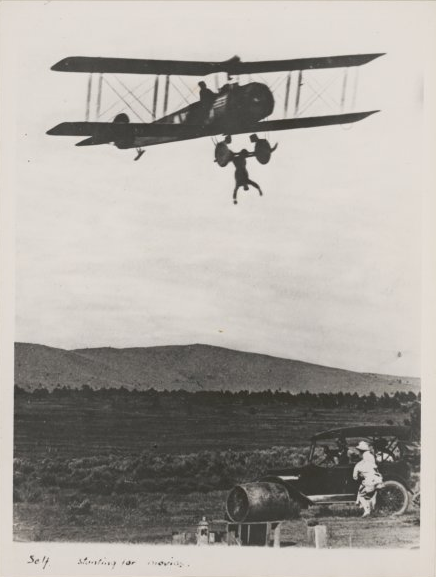 Charles Kingsford Smith stunting for the movies, California, 1922. After serving in Australian squadrons in the Royal Flying Corps in World War 1, Kingsford-Smith went to Hollywood to do stunt flying. Among the stunts were wing-walking and hanging by his legs from undercarriages. (NLA 3723531)
Charles Kingsford Smith stunting for the movies, California, 1922. After serving in Australian squadrons in the Royal Flying Corps in World War 1, Kingsford-Smith went to Hollywood to do stunt flying. Among the stunts were wing-walking and hanging by his legs from undercarriages. (NLA 3723531)
Red Baron rediscovered
Lt. E.C. Banks and the Red Baron’s last flight uncovered some personal connections. These included the discovery a fabric swatch taken from the Red Baron’s triplane by my great-grandfather’s brother. So old Uncle Bill’s stories were true!…A 6th grade project re-discovered whilst finishing the article also added a nice sense of closure. ‘A small, irregular piece of fabric from the underside of von Richthofen’s triplane. The section has been roughly handled, and only traces of red paint remain over the factory applied blue finish. The reverse side is captioned “Baron Von Richthofen Shot Down France 21/4/1918 – Sapper W. Ch_ (Christie). A letter from Christie is included.’
‘A small, irregular piece of fabric from the underside of von Richthofen’s triplane. The section has been roughly handled, and only traces of red paint remain over the factory applied blue finish. The reverse side is captioned “Baron Von Richthofen Shot Down France 21/4/1918 – Sapper W. Ch_ (Christie). A letter from Christie is included.’
 Assignment on (West) Germany by Darragh Christie, 6 Blue, with illustration showing Red Baron’s red triplane chased by Lt. Brown’s Camel and shot at by ground troops with a question mark over the Somme.
Assignment on (West) Germany by Darragh Christie, 6 Blue, with illustration showing Red Baron’s red triplane chased by Lt. Brown’s Camel and shot at by ground troops with a question mark over the Somme.
Is it a bird? is it a plane? no..
Its a Zeppelin! This photo was taken by a seaman aboard HMAS Sydney just as the giant dirigible, L43, was dropping its bombs high above…
 The German Zeppelin L43, photographed by Able Seaman G Leahy, who lay on his back while HMAS Sydney was being bombed by 10 bombs each weighing 250 pounds.
The German Zeppelin L43, photographed by Able Seaman G Leahy, who lay on his back while HMAS Sydney was being bombed by 10 bombs each weighing 250 pounds.
The following photos were taken on a trip to the Fleet Air Arm Museum near Nowra. They were great for the article After Cocos: HMAS Sydney’s progress.

 Model Of HMAS Sydney (I) at Fleet Air Arm Museum, Nowra. Full view of ship and close-up showing Sopwith fighter on launching platform. Photo taken by the Author
Model Of HMAS Sydney (I) at Fleet Air Arm Museum, Nowra. Full view of ship and close-up showing Sopwith fighter on launching platform. Photo taken by the Author
From the same article another interesting image of Sydney’s Sopwith Camel being dragged from the water. A reminder that these early aircraft were made of wood and canvas!
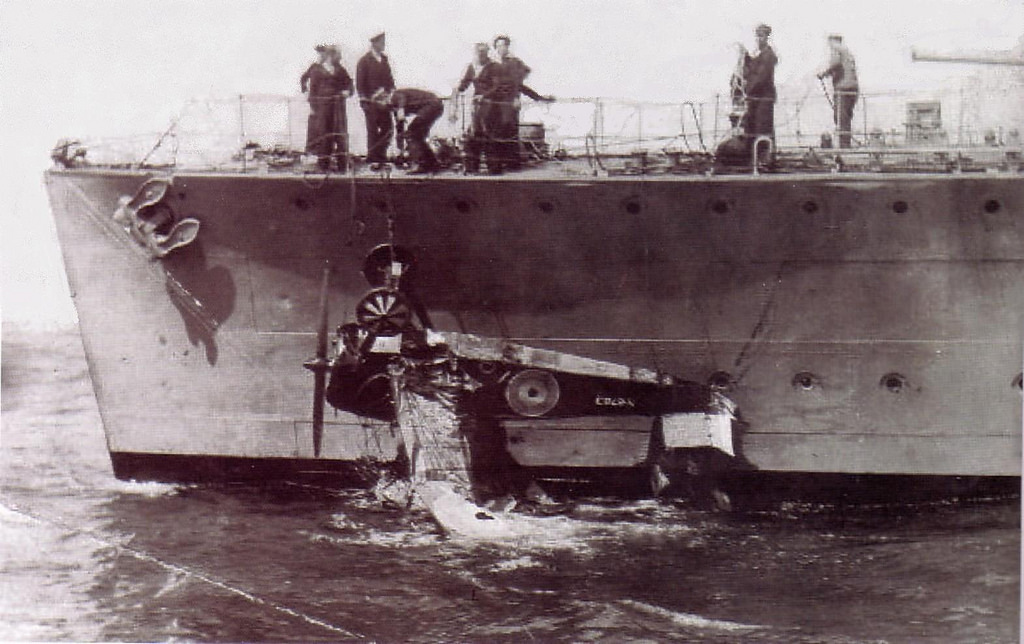 Sopwith Camel (N6783 ?) salvaged from the sea (by HMAS Sharpshooter) A landing of this sort usually resulted in the aeroplane doing a cart-wheel with dire consequences for the pilot. Photo from Horatio J. Kookaburra’s Flickr post.
Sopwith Camel (N6783 ?) salvaged from the sea (by HMAS Sharpshooter) A landing of this sort usually resulted in the aeroplane doing a cart-wheel with dire consequences for the pilot. Photo from Horatio J. Kookaburra’s Flickr post.
Maritime Memorials
HMAS Sydney
This photograph of Sydney’s Bow at Milsons Point was memorable. As
was taking it a huge storm swept in. With a few unlucky tourists I sought shelter under the Harbour Bridge, to keep myself, and more importantly the brand new iphone, from getting drenched.
 Bow of HMAS Sydney at Milsons Point, North Sydney with Opera House in background. Photo taken by the author 9/11/15
Bow of HMAS Sydney at Milsons Point, North Sydney with Opera House in background. Photo taken by the author 9/11/15
 Bow of HMAS Sydney at Milsons Point, North Sydney. Note storm coming in from the south-west. Photo taken by the author 9/11/15
Bow of HMAS Sydney at Milsons Point, North Sydney. Note storm coming in from the south-west. Photo taken by the author 9/11/15
The Mast at Bradleys head was snapped from a Watson’s Bay ferry, heading back to the Quay. It was a bit blurry, so I used this one.
 HMAS Sydney mast at Bradleys Head seen from Watsons Bay to Circular Quay ferry. Photo by the Author.
HMAS Sydney mast at Bradleys Head seen from Watsons Bay to Circular Quay ferry. Photo by the Author.

Original plans for the seating and positioning of guests, dignitaries and members of the public for the HMAS Sydney Memorial Mast ceremony at Bradley’s Head, Nov. 24th 1934. Source: Trace, Mosman Digital Archive. From: HMAS Sydney’s mast dedication, 80 years ago today.
SMS Emden
Taking photos from all angles, I tried to imagine the Emden gun unveiling on 21/11/1917. (The podium filled with dignitaries, speeches, and hecklers in the crowd.) I was once like the thousands of passers-by who have no idea about its history. Not any more.
 Sydney memorial in Hyde park. SMS Emden Gun pointing up Oxford St. Photo by the author. Taken on 100th anniversary of its unveiling 21/11/2017 From: After Cocos: Sydney-Emden memorial unveiled!
Sydney memorial in Hyde park. SMS Emden Gun pointing up Oxford St. Photo by the author. Taken on 100th anniversary of its unveiling 21/11/2017 From: After Cocos: Sydney-Emden memorial unveiled!
 B&W Photograph ‘Unveiling the Emden Gun: Captain Glossop addressing the crowd.’
B&W Photograph ‘Unveiling the Emden Gun: Captain Glossop addressing the crowd.’
Gallows humour
The following picture was used for Hill 60 and the lost 18th: Aug. 22, 1915. A perfect fit for the story by Joe Maxwell about his war experiences in the 18th Battalion with fellow stretcher bearer, the laconic and unflappable ‘Murphy’. David Crothers Barker, the illustrator, had Mosman connections.

Who was she?
What was her life like?
I was able to add this scanned image from Trace to the Hill 60 post. There are very few online images of Cairo’s inhabitants at the time. Sometimes the best places to look are right under your nose.

Postcard sent home by Joseph Edward Crew. Source: Barry’O Keefe Library ‘Trace’ digital archive. Lent by Ken Nugent, Joseph Edward Crew’s nephew, for the scan-a-thon. From: Hill 60 and the lost 18th: Aug. 22, 1915.
A General and his war horse.
The picture below shows the war horse ‘Sandy’. His owner, General William Bridges stands behind. They were the only Soldier and horse to be re-buried in Australia.

Bridges holding the bridle of his favourite charger, Sandy. The horse is a 15.3 hands high bay gelding with a white star. They are standing in front of the tents of the 1st Australian Division at the Mena Camp, Egypt, prior to embarkation to Gallipoli. (AWM
P05290.001) For further reading see: They charged but didn’t come home and The death of a gallant and erudite soldier.
The healing arts
The story Margaret Preston and the healing arts is less about ‘the horror’ and more, as the title suggests, about the arts. The photo below shows shell-shocked soldiers learning basket weaving . Margaret Preston (nee McPherson) is just out of the picture. Her black Scottish Terrier Little Jim, however, can be seen sitting next to her in the bottom right-hand corner!

A Letter from a father-soldier
These photographs from Trace were quite poignant.

Above, Joseph Edward Crew with infant son Leonard Frank (b. 28/08/1914.) Below is a letter to his daughter Winnie and 2 other children.

To my pretty little girl Winnie, here is poor daddy making pictures for his children. Look at the cocky with the pipe and hat. You be good and I will bring you something lovely. Love from Daddy xxxxxxxx
Captain Joseph Crew was killed in Belgium on 20/08/1917.
…and from a distraught mother
Sarah Laing wrote desperately seeking news about her son, ‘missing’ after the battle of Fromelles. One letter was scrawled on the back of a Taronga Zoo opening programme. A chance find whilst researching the story Cobbers remembered: Lost Diggers of the 53rd.
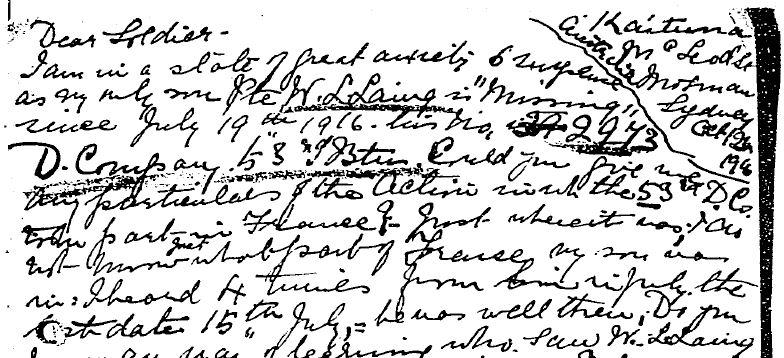 a letter written by a Mosman mother Sarah Laing enquiring about her son William.
a letter written by a Mosman mother Sarah Laing enquiring about her son William.
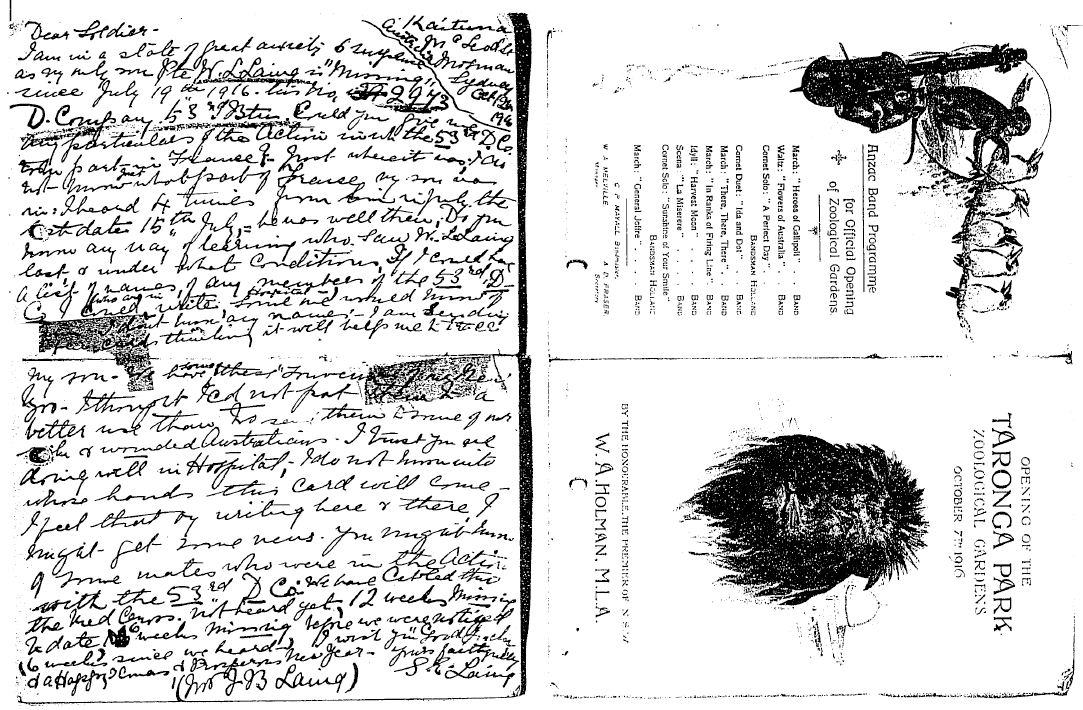 Sarah Laing’s letter asking after her son (AWM R149302) From: Viewing the monkey enclosure: perspectives left and right
Sarah Laing’s letter asking after her son (AWM R149302) From: Viewing the monkey enclosure: perspectives left and right
News and entertainment
The following images are from the Mosman Daily. What caught my eye were adverts for the Wings and Metropolis They appear near an article on Charles Kingsford-Smith and Charles Ulm’s arrival in 1928.
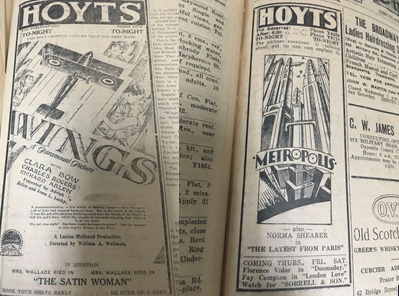
 ‘The Daily’ Nov. 1934. Article on the dedication ceremony of the Sydney Mast in 1934.
‘The Daily’ Nov. 1934. Article on the dedication ceremony of the Sydney Mast in 1934.
Enemy aliens
Interesting photos I happened across included one of SMS Emden’s crewmen proudly displaying models of his beloved ship. Images of Holsworthy (and other internment camps) show inmates engaging in organised sporting, social and cultural activities.
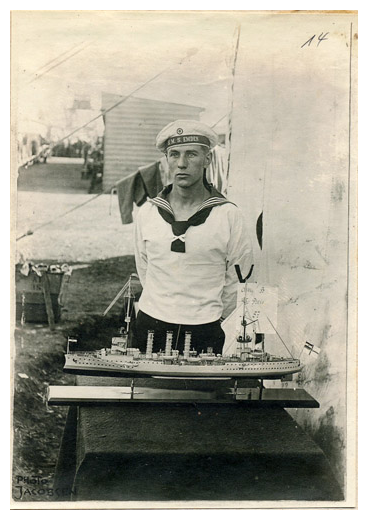 Internee’s scale model of the SMS Emden, Holsworthy Internment Camp, c.1915. Photograph Heinrich Jacobsen, Dubotzki Collection, Germany. Source: NSW Migration Centre ‘The enemy at home.’
Internee’s scale model of the SMS Emden, Holsworthy Internment Camp, c.1915. Photograph Heinrich Jacobsen, Dubotzki Collection, Germany. Source: NSW Migration Centre ‘The enemy at home.’
 Hans Overbeck (centre) in a theatre production put on by prisoners in Holsworthy camp. Source: retrieved online at https://jonolineen.com/2014/07/27/on-the-inside/
Hans Overbeck (centre) in a theatre production put on by prisoners in Holsworthy camp. Source: retrieved online at https://jonolineen.com/2014/07/27/on-the-inside/
From: After Cocos: Holsworthy Concentration Camp
On the model ship theme I came across this eye-catching model presented to the Australian Government in 1925. The Ibuki is named after a mountain in Japan. Her sister ship Kurama’s namesake was of even greater mythological significance.
 Model of the Japanese battle cruiser ‘Ibuki’ in approximately 1:96 scale, constructed from material salvaged from the original ship and built at Kure, Japan. Finished in black and red lacquer and depicted with starboard anti-torpedo skirts deployed.
Model of the Japanese battle cruiser ‘Ibuki’ in approximately 1:96 scale, constructed from material salvaged from the original ship and built at Kure, Japan. Finished in black and red lacquer and depicted with starboard anti-torpedo skirts deployed.
The Ibuki was given in the spirit of friendship. Quoting the AWM:
Mr Yamasaki, stated he hoped the gift would be accepted ‘as undeniable evidence that the same friendly and cordial relations will remain unchanged between the Commonwealth and Japan, and are as strong as when the ‘Ibuki’ conveyed the brave Anzacs to the battle front, there to gain imperishable renown for their patriotism and courage. I feel confident that the action of Japan in this instance will counterbalance and set-off some of the unkind words which misinformed people occasionally indulge in regarding the intentions of Japan towards Australia’.[i.e. Billy Hughes and the White Australia movement’s xenophobia, Japanese Imperialist designs were still a few years away.]
Divisions on the home front
The two images below came from Trove for the post 2nd Lt. Bill Taylor and the Valentine’s day mutiny, 1916. They depict soldiers marching through Sydney streets. A very rare visual record of what it was like on that hot, riotous day in February, 1916. (Thanks Bernard!)

‘THE LIVERPOOL CAMP MUTINY. WAS IT “GERMAN INFLUENCE AND GOLD?” THE PROCESSION IN GEORGE STREET.’, The Mirror of Australia, 19 February 1916 (Image: Trove)

Unionism in Excelsis – Soldiers on Strike, Liverpool 14 Feburary 1916. Daily Telegraph, 15 February 1916, p 7. (Image: NLA NX 277)
Other stories on the industrial unrest on the home front include: The Blood Vote: Divisions at the Front, and at Home, and A light on the Hill: The Great Strike, 1917.
Bernard’s finds
The first image comes from Bernard de Broglio’s story I would not change with the ground grubs for worlds: Captain G. F. Malley M.C. It shows Captain Malley barnstorming over Martin Place. No photoshop here…!
 AIRMAN ASTONISHES SYDNEY. Captain Malley, M.C., flew among the housetops of the city in aid of the Peace Loan campaign. The main picture shows him hovering over the flagstaff of the General Post Office tower. In the inset he is seen performing an exciting nose-dive.
AIRMAN ASTONISHES SYDNEY. Captain Malley, M.C., flew among the housetops of the city in aid of the Peace Loan campaign. The main picture shows him hovering over the flagstaff of the General Post Office tower. In the inset he is seen performing an exciting nose-dive.
— Barrier Miner, Saturday 11 October 1919
The image below is from AIF graffiti links Mosman to Naours and shows stretcher-bearer Allan Allsop, ‘was here’ in the Naours underground, in 1917.

Other stories by Bernard include: Pusher ace: Captain Lancelot Lytton Richardson and Lucky 13: Dibbs at the front
Bernard got the project up and running and edited and posted my earlier articles. It has not been easy keeping the project going, but persistence has paid off.
Oh well, just a few more to go before my bit is done..!